#Model C Roman
Explore tagged Tumblr posts
Text
Just a Crush || OP81
☆ summary: Swimmer, y/n, is headed to the olympics and little does she know she’s f1 driver oscar piastri’s celebrity crush
☆ pairing: oscar pisatri x olympian!reader
☆ f/c and warnings: none
☆ requested: this was suggested!! tysm for the wonderful idea for a swimmer reader 🫶🏻
゚. ✿ ୨❤︎୧⠀✿ . ゚⠀
ynuser made a post

liked by yourbff, thenzteam, vogue, yoursibling, oscarpiastri, iamrebeccad, and 87,457 others
ynuser: your girl is in her model era 🌿 thank you to vogue for having me! make sure to check out the july issue where i talk about what it means to me to be headed to the olympics to represent new zealand, my daily routines, and my life outside of swimming! see you all in paris 🤍
view all 147 comments
yourbff: you are so effortlessly gorgeous please 😫
thenzteam: we are lucky to have you y/n!
user1: my favorite kiwi
user2: omg not y/n revealing she’s a huge fan of f1!! wait till oscar hears about this
user3: oscar who?
user2: he’s a formula 1 driver who has a massive crush on y/n
user3: omg not a vroom vroom aussie for my girl 😭
user4: stop they would be perfect 😭 they give the same energy
user2: he’s hiding in the likes 👀
iamrebeccad: some of the best shots i’ve ever seen! congrats on being in vogue and going to the olympics ❤️
ynuser: i took notes from the pro 🫶🏻
user2: omg rebecca is here too
williamsracing has posted a video
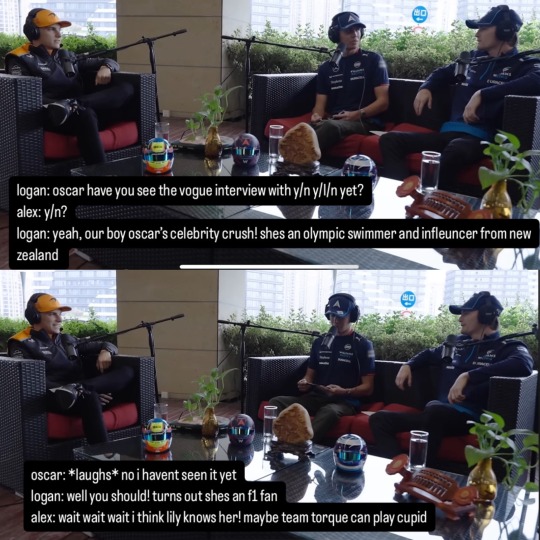
user12: LOSCAR MY LOVES
user5: alex and logan are my fav duo im going to miss them so much
user6: james when i catch you!!! how dare you break up our family
user4: GUYS Y/N MENTIONED
user9: the way oscar blushes omg
user10: mans is down bad we have to get her to notice him
user11: alex best be texting lily rn to make that connection! our boy has like no game
user12: stoppp i’m sure he has some 😭
user11: idk he’s so quiet and reserved
user12: nahhh it’s always the quiet ones ok
user8: y/noscar is my roman empire
user13: let’s get my man to the paris
ynuser posted a story

view story replies
user10: hey babes, congrats on the olympics. im here to lyk abt a very cool, very polite young man named oscar piastri
yourbff: make us proud y/n
ynuser: i’ll do my best 😭
user2: you should visit monaco and oscar piastri next
lilymhe: yayyyy let’s goooooo y/n!!! i’ll be cheering for you!!
ynuser: omg lily!! it’s been too long since i’ve seen you! let’s do something once i’ve won the gold 😉
lilymhe: yes please 🫶🏻
lilymhe: also alex told me to tell you that you have got to come to a grand prix soon - zandvoort maybe?
oscarpiastri: good luck y/n!
ynuser has made a post

liked by alex_albon, thenzteam, oscarpiastri, vogue, ilonamaher, lilymhe, and 98,657 others
ynuser: you’re looking at the fastest woman in the 1500 freestyle! semifinals here we come 🇳🇿
view all 879 comments
yourbff: being able to be poolside cheering you on is my favorite thing
ynuser: i love you
alex_albon: congrats y/n! can’t wait to see you soon 😉
user16: ALEX WHAT ARE YOU EOING HERE
user18: SEE YOU SOON????
user22: alex is taking his job as matchmaker seriously
thenzteam: aotearoa is so proud you ❤️
ynuser: 🤍
oscarpiastri: congrats y/n!! you’re going to get the gold i just know it
ynuser: thank you oscar!! i’m certainly going to try
user2: oscar jumping up and down in his driver room rn
landonorris: user2 he is celebrating yes
user2: LANDODNJE
logansargeant: oscarpiastri thanks for saving my dog from that burning building the other day
alex_albon: thanks oscarpiastri for lending me your lambo last week
ynuser: wow! oscarpiastri can you lend me your lambo?
oscarpiastri: ynuser that can be arranged
thenzteam has made a post
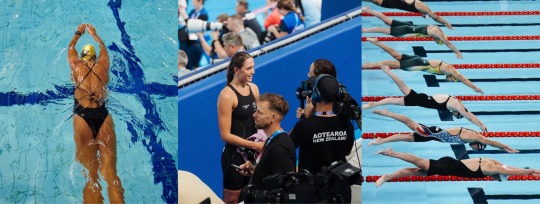
liked by ynuser, nz_swimming, yourbff, iamrebeccad, alex_albon, oscarpiastri and 67,455 others
thenzteam: she’s done it!!! y/n has won gold in the 1500 freestyle! you have made new zealand, aotearoa so very proud 🌿🇳🇿
view all 203 comments
ynuser: beyond proud to be a kiwi! 🤍
yourbff: you are a star!!! i’m so proud of you
thenzteam: we love you 🫶🏻 now it’s time for you to get some rest!
user18: LETS GOOO Y/N!!!!
user20: i love watching women succeed
lilymhe: CONGRATS MS GIRL
alex_albon: yes!!! congrats ms y/n!!!!!
oscarpiastri: bwoah!! let’s go!
user22: oh oscar is this all you’ve got
landonorris: user22 nah he’s got more just give him a minute
oscarpiastri: lando please
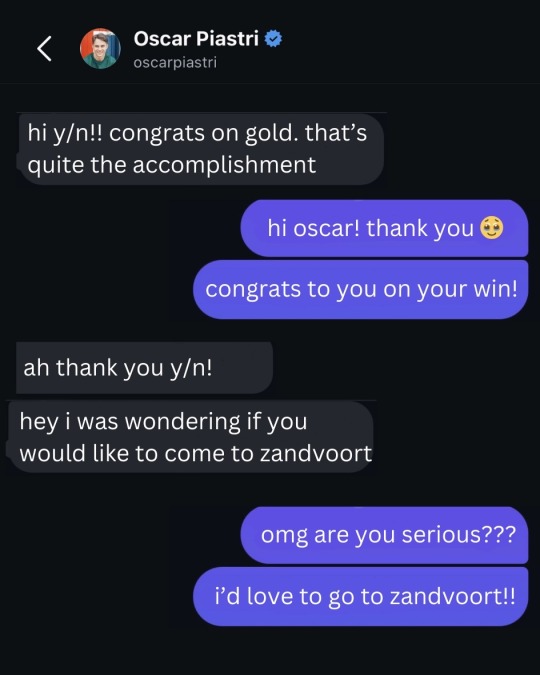
ynuser has posted a story

view all story replies
lilymhe: i missed you so much my olympic golden girl. i’m so glad you’re here 🫶🏻
ynuser: i missed you too my queen 🧡
user28: OMG YOURE IN ZANDVOORT OMG OMGOMGOGKGOGMGMGG
iamrebeccad: the way i jumped for joy when you told me you were coming!!! i can’t wait for dinner tonight
ynuser: neither can i!! i am really looking forward to meeting carlos too
user44: zandvoort!!! on race weekend!!!!! you’re giving our polite cat a chance!!!!
user45: girly we know exactly where you are 🤭
ynuser has made a post

liked by alex_albon, iamrebeccad, lilymhe, oscarpiastri, thenzteam, and 91,234 others
ynuser: some much needed downtime after paris but don’t worry i still got some laps in 🥹
tagged: lilymhe, iamrebeccad, mclarenf1
view all 867 comments
user56: not her tagging mclaren and not oscar LOL
user87: THOUGHT YOU COULD SNEAK IN THATBLAST PIC HUH
user45: that’s gotta be oscar
user87: it’s absolutely him ain’t no way
mclarenf1: was wonderful getting to have an olympic gold medalist in our garage this weekend!! thank you for visiting 🧡
ynuser: thank you for having me mclaren 🧡
oscarpiastri: hey that’s my car
ynuser: yeah and you didn’t let me borrow it like you said you would 😭
oscarpiastri: i’ll lend you one that’s a little less dangerous! you’re precious cargo after all 😉
landonorris: ok , leave me out of the pics… i thought we were friends??
ynuser: my bad dawg! didn’t realize we were chill like that
landonorris: well we’re not anymore!!
alex_albon: my work here is done! team torque for the win
logansargeant: mission accomplished
lilymhe: girls u know everyone can see your comments
user45: CONFIRMED! THANKS ALBONO AND LOGIE
user46: AHHHHHHHHHHHH
゚. ✿ ୨❤︎୧⠀✿ . ゚⠀
a/n: another olympic reader!!! i love sports player reader. next up - olympic!tennis!reader.
a/n: made some updates to my blog and made a masterlist wahoo!! ty for all the support
゚. ✿ ୨❤︎୧⠀✿ . ゚⠀
© norrisainz33: please do not rewrite, translate, or copy any of my works posted here on to any other platform
#f1 fandom#formula 1#f1 fanfic#f1 imagine#f1 smau#f1 social media au#f1 x reader#formula 1 fanfic#formula 1 imagine#formula 1 x reader#op81#op81 x reader#op81 imagine#op81 fic#op81 fluff#op81 x you#op81 x y/n#op81 smau#op81 social media au#oscar piastri#oscar piastri x reader#oscar piastri x you#oscar piastri smau#oscar piastri social media au#oscar piastri fic#oscar piastri fanfic
2K notes
·
View notes
Text
Caution: Universe Work Ahead 🚧
We only have one universe. That’s usually plenty – it’s pretty big after all! But there are some things scientists can’t do with our real universe that they can do if they build new ones using computers.
The universes they create aren’t real, but they’re important tools to help us understand the cosmos. Two teams of scientists recently created a couple of these simulations to help us learn how our Nancy Grace Roman Space Telescope sets out to unveil the universe’s distant past and give us a glimpse of possible futures.
Caution: you are now entering a cosmic construction zone (no hard hat required)!
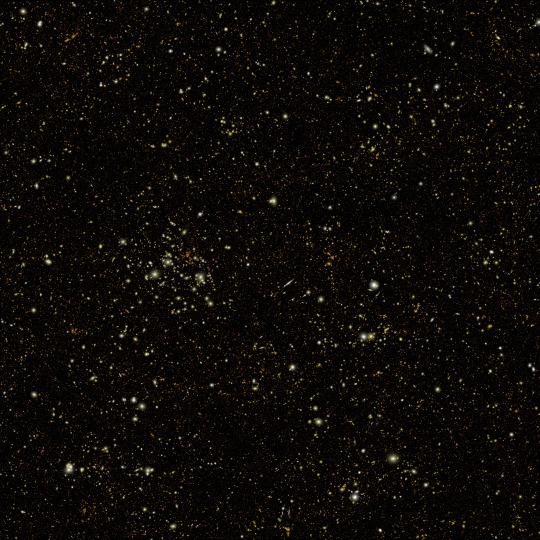
This simulated Roman deep field image, containing hundreds of thousands of galaxies, represents just 1.3 percent of the synthetic survey, which is itself just one percent of Roman's planned survey. The full simulation is available here. The galaxies are color coded – redder ones are farther away, and whiter ones are nearer. The simulation showcases Roman’s power to conduct large, deep surveys and study the universe statistically in ways that aren’t possible with current telescopes.
One Roman simulation is helping scientists plan how to study cosmic evolution by teaming up with other telescopes, like the Vera C. Rubin Observatory. It’s based on galaxy and dark matter models combined with real data from other telescopes. It envisions a big patch of the sky Roman will survey when it launches by 2027. Scientists are exploring the simulation to make observation plans so Roman will help us learn as much as possible. It’s a sneak peek at what we could figure out about how and why our universe has changed dramatically across cosmic epochs.
youtube
This video begins by showing the most distant galaxies in the simulated deep field image in red. As it zooms out, layers of nearer (yellow and white) galaxies are added to the frame. By studying different cosmic epochs, Roman will be able to trace the universe's expansion history, study how galaxies developed over time, and much more.
As part of the real future survey, Roman will study the structure and evolution of the universe, map dark matter – an invisible substance detectable only by seeing its gravitational effects on visible matter – and discern between the leading theories that attempt to explain why the expansion of the universe is speeding up. It will do it by traveling back in time…well, sort of.
Seeing into the past
Looking way out into space is kind of like using a time machine. That’s because the light emitted by distant galaxies takes longer to reach us than light from ones that are nearby. When we look at farther galaxies, we see the universe as it was when their light was emitted. That can help us see billions of years into the past. Comparing what the universe was like at different ages will help astronomers piece together the way it has transformed over time.

This animation shows the type of science that astronomers will be able to do with future Roman deep field observations. The gravity of intervening galaxy clusters and dark matter can lens the light from farther objects, warping their appearance as shown in the animation. By studying the distorted light, astronomers can study elusive dark matter, which can only be measured indirectly through its gravitational effects on visible matter. As a bonus, this lensing also makes it easier to see the most distant galaxies whose light they magnify.
The simulation demonstrates how Roman will see even farther back in time thanks to natural magnifying glasses in space. Huge clusters of galaxies are so massive that they warp the fabric of space-time, kind of like how a bowling ball creates a well when placed on a trampoline. When light from more distant galaxies passes close to a galaxy cluster, it follows the curved space-time and bends around the cluster. That lenses the light, producing brighter, distorted images of the farther galaxies.
Roman will be sensitive enough to use this phenomenon to see how even small masses, like clumps of dark matter, warp the appearance of distant galaxies. That will help narrow down the candidates for what dark matter could be made of.

In this simulated view of the deep cosmos, each dot represents a galaxy. The three small squares show Hubble's field of view, and each reveals a different region of the synthetic universe. Roman will be able to quickly survey an area as large as the whole zoomed-out image, which will give us a glimpse of the universe’s largest structures.
Constructing the cosmos over billions of years
A separate simulation shows what Roman might expect to see across more than 10 billion years of cosmic history. It’s based on a galaxy formation model that represents our current understanding of how the universe works. That means that Roman can put that model to the test when it delivers real observations, since astronomers can compare what they expected to see with what’s really out there.

In this side view of the simulated universe, each dot represents a galaxy whose size and brightness corresponds to its mass. Slices from different epochs illustrate how Roman will be able to view the universe across cosmic history. Astronomers will use such observations to piece together how cosmic evolution led to the web-like structure we see today.
This simulation also shows how Roman will help us learn how extremely large structures in the cosmos were constructed over time. For hundreds of millions of years after the universe was born, it was filled with a sea of charged particles that was almost completely uniform. Today, billions of years later, there are galaxies and galaxy clusters glowing in clumps along invisible threads of dark matter that extend hundreds of millions of light-years. Vast “cosmic voids” are found in between all the shining strands.
Astronomers have connected some of the dots between the universe’s early days and today, but it’s been difficult to see the big picture. Roman’s broad view of space will help us quickly see the universe’s web-like structure for the first time. That’s something that would take Hubble or Webb decades to do! Scientists will also use Roman to view different slices of the universe and piece together all the snapshots in time. We’re looking forward to learning how the cosmos grew and developed to its present state and finding clues about its ultimate fate.
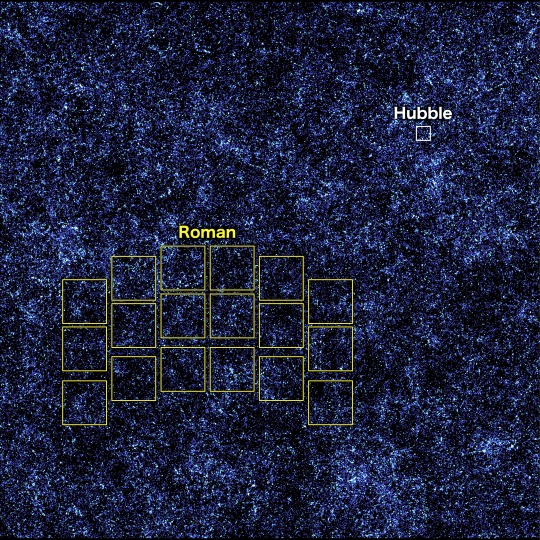
This image, containing millions of simulated galaxies strewn across space and time, shows the areas Hubble (white) and Roman (yellow) can capture in a single snapshot. It would take Hubble about 85 years to map the entire region shown in the image at the same depth, but Roman could do it in just 63 days. Roman’s larger view and fast survey speeds will unveil the evolving universe in ways that have never been possible before.
Roman will explore the cosmos as no telescope ever has before, combining a panoramic view of the universe with a vantage point in space. Each picture it sends back will let us see areas that are at least a hundred times larger than our Hubble or James Webb space telescopes can see at one time. Astronomers will study them to learn more about how galaxies were constructed, dark matter, and much more.
The simulations are much more than just pretty pictures – they’re important stepping stones that forecast what we can expect to see with Roman. We’ve never had a view like Roman’s before, so having a preview helps make sure we can make the most of this incredible mission when it launches.
Learn more about the exciting science this mission will investigate on Twitter and Facebook.
Make sure to follow us on Tumblr for your regular dose of space!
#NASA#astronomy#telescope#Roman Space Telescope#dark matter#galaxies#cosmology#astrophysics#stars#galaxy#Hubble#Webb#spaceblr
2K notes
·
View notes
Text
Mini PAC - Details about your soulmate/TF using game cards and letters



Group 1 - Cassette
Banana card : they are fruity! If they’re a man, they have big D energy. They are joyful. They come from a warm climate country. Possibly an island.
Bunny card : this person is super cute and lovely. They look like a baby. They are very kind and soft with others. They have a high sex drive. Their teeth and ears could be parts of their body that you like about them. They feel very innocent and vulnerable.
Airplane card : this person likes to travel for fun and/or travels a lot for work. They live at a distance from you. They enjoy fast communication. They are active. They are curious and love to be challenged.
Letters : T H U N L I I O E Z E I C U Y I M A
Words or names I picked up on ( feel free to add more to the list in the comments) :
Liam, Theo, Noah, Noe, Zain, Zina, Zelie, Mona, Mina, Naim, Chloé, Chile, Lucy, Milan, Athene, Luna, China, mole, eye, cutie, cinema, zinc, camel, thyme, chain, lion, Leo, Helio, Nile, mint, maze, hazel, mountain, cunt, aconite, Lyna, Lina, Alice, menace, county, yen, Celine, TMI, TUE(sday), OCT(ober), autumn, Ciel, honey, Luca, Han, menu, hate, anime
Group 2 - Subway
Bicycle and train card : they live at a distance from you but it could be easily accessible. They enjoy traveling and/or they travel for work. They like biking.
Dress card : they are pretty feminine. They like to dress unconventionally. So if they’re a man, they like to wear skirts or high heels, to put on makeup. If they’re a woman, they’re a bit of a tomboy. They enjoy fashion in general. They could be a model.
Dolphin card : they are sociable. Their family matters a lot to them. They are very sensitive and in tune with their intuition. They have a kind and generous heart. They are playful, even flirty. They like water and/or leave near a body of water.
letters : W E E M S A U T T B A E E O R E N R
Words and names I picked up on (feel free to add more to the list in the comments) : tenor, Muse, water, Mona, Mason, Saturn, Beau, war, ram, Taurean, brat, bae, West, euro, won, MON(day), mount, sun, tarot, bus, runes, tan, beast, Roman, Roma, Meteora, Mars, ASMR, Ares, Arena, amore, nature, muerte, mentor, senor, Matteo, master, webmaster, woman, man, Erasme, Bruno, brunette, same, torn, tears, BTS, Naruto, Moana
Group 3 - Snacks
Letters X L N E J E E A O N A H N N L I R W L
Words and names I picked up on (feel free to add to the list in the comments) :
Hélène, Helena, Nia Jax, jail, Leo, Xena, hell, Joan, Joana, Jane, Jean, Jona, jean, Noel, Noe, Noa, lion, JAN(uary), Wall E, halo, hola, hello, Axel, Hoax, Jihane, Will, Jorah, horn, Jael, Jeanne, norn, helix, Halle, alien, Rollex, Rollin, Alienor, Jolie, Rio, Janeiro, Nelliel, Ronnie, Leon, Johann, Neil
Watermelon card : They support Palestine. They come from a warm climate country. They love summer. They love watermelon. They like your juice ;)
Tennis ball card : They are athletic. They enjoy tennis or any type of ball game. They got balls ;) They are swift and fast. They communicate quickly, they are witty and sarcastic.
Socks card : You'd feel very cozy with them. They have an odd but warm personality. They enjoy date nights snuggling by the fireplace or Netflix and chilling. They have cold feet.
213 notes
·
View notes
Text


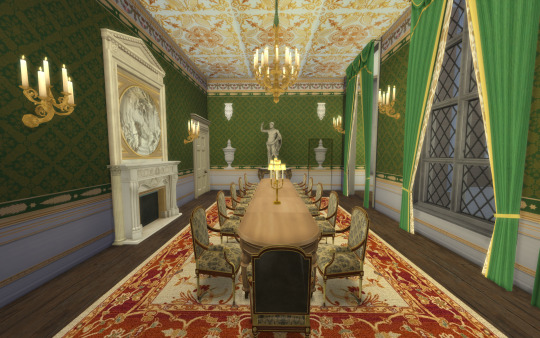

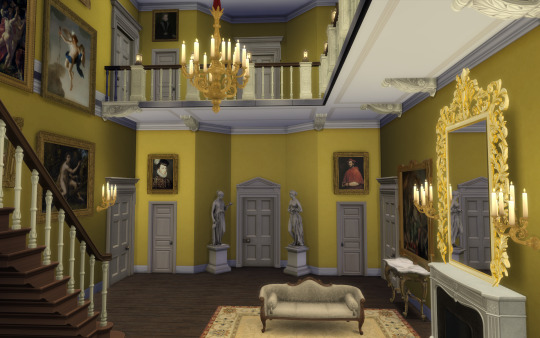

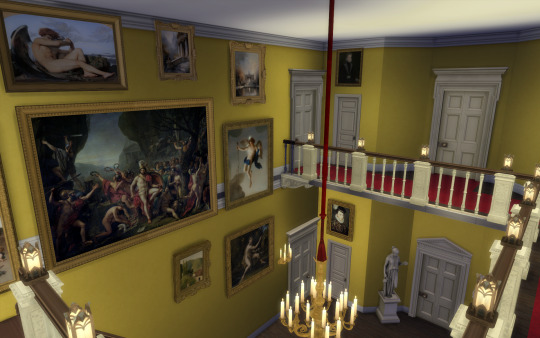

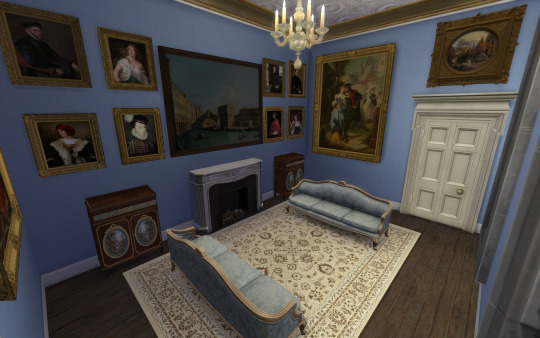




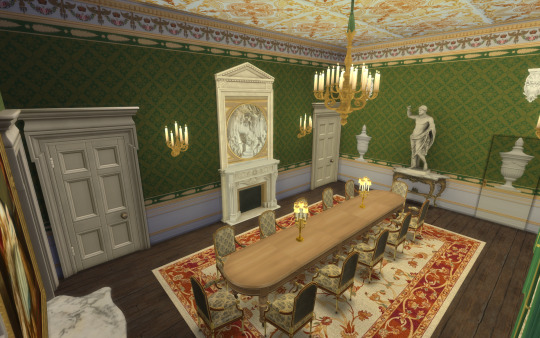
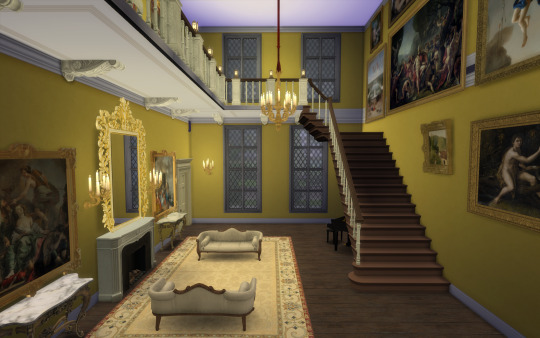





Burton Constable Hall
Hi guys!!
I'm sharing Burton Constable Hall. This is the 19th building for my English Collection.
I decorated most of the house ground floor, for reference.
History of the house: Burton Constable Hall is a large Elizabethan country house in England, with 18th- and 19th-century interiors.
Despite its apparent uniformity of style, Burton Constable has a long and complicated building history. The lower part of the north tower, built from limestone, is the oldest part of the house to survive and dates to the 12th century, when a medieval pele tower served to protect the village of Burton Constable from the time of the reign of King Stephen. In the late 15th century a new brick manor house was built at Burton Constable, eventually replacing Halsham as the family's principal seat. In the 1560s Sir John Constable embarked on the building of the Elizabethan prodigy house that stands today. This incorporated remains of the earlier manor house along with the addition of the new range containing a Great Hall, which rose the full height of the building and was top-lit by a lantern, along with a Parlour, Chambers and South Wing.
By the 18th century, the Great Hall must have seemed old fashioned, and a surviving design of c. 1730 suggests that Cuthbert Constable intended to completely remodel the interior. However, it appears that remodelling was not undertaken until the 1760s when his son William Constable commissioned a number of architects for designs. These included John Carr, Timothy Lightoler and Capability Brown. The decorative plasterwork was executed by James Henderson of York. At this time, Constable also acquired the plaster figures of Demosthenes and Hercules with Cerberus, and plaster busts of the Roman emperor Marcus Aurelius Antoninus and the Greek poet Sappho, from the sculptor John Cheere. Above the fireplace is a carving of oak boughs and garlands of laurel leaves, crowned by the Garter Star, surrounding the armorial shield of the Constable family in scagliola by Domenico Bartoli.
The dining room was substantially remodelled by William Constable in the 1760s, who commissioned designs from Robert Adam, Thomas Atkinson, and Timothy Lightoler (who won the commission). The ceiling draws on contemporary interest in the excavations at Pompeii and Herculaneum, with plasterwork by Giuseppe Cortese. The overmantel plaque of Bacchus and Ariadne riding on a panther was modelled on famous antique cameos illustrated in Pierres Antiques Gravées, published 1724 by Philip, Baron von Stosch and Bernard Picart. This room was again redecorated in the 19th century.
Link: https://en.wikipedia.org/wiki/Burton_Constable_Hall
------------------------------------------------------------------------------
This house fits a 50x50 lot.
I only decorated some of the important rooms. All the rest of the house is up to your taste to decor.
Hope you like it.
You will need the usual CC I use:
all Felixandre cc
all The Jim
SYB
Anachrosims
Regal Sims
King Falcon railing
The Golden Sanctuary
Cliffou
Dndr recolors
Harrie cc
Tuds
Lili's palace cc
Please enjoy, comment if you like the house and share pictures of your game!
Follow me on IG: https://www.instagram.com/sims4palaces/
@sims4palaces
Download: https://www.patreon.com/posts/112319879
Public: 21/10/2024
#sims 4 architecture#sims 4 build#sims4#sims 4 screenshots#sims4building#sims 4 historical#sims4play#sims4palace#sims 4 royalty#ts4#ts4 download#ts4 simblr#ts4 gameplay#ts4 screenshots#sims 4#the sims 4#sims#simblr#sims 4 gameplay#my sims#the sims#sims build#sims 4 simblr
70 notes
·
View notes
Text

Mare Nectaris ("Sea of Nectar") on the Moon // Loxley
Read below the cut for some info about some of the craters in this image!
Mare Nectaris is a lunar sea, or maria, one of the darker on the near side of the Moon. It is about 210 miles across and filled with dried lava.
Above it is Sinus Asperitatis, Latin for "Bay of Roughness". This "bay" joins Mare Nectaris to Mare Tranquillitatis.
Three craters line Mare Nectaris to the west.
Theophilus crater is named after Theophilus I of Alexandria (bef. 384 - 412), the 23rd Pope of Alexandria. He wrote a Paschal table that tracks the Moon's phases to aid in determining the date of Easter.
Cyrillus crater is named after Saint Cyril of Alexandria (c. 376 - 444), the 24th Pope of Alexandria. He also constructed a Paschal table to calculate the date of Easter.
Catharina crater is named for Saint Catherine of Alexandria (c. 287 - c. 305), a martyr and early adopter of Christianity in the Roman empire. However, there is little evidence to support her existence as a historical figure.
A few craters lie to the south of Mare Nectaris:
Beaumont crater is named for the French geologist Léonce Élie de Beaumont (1798-1874) who proposed a theory for the origin of mountain ranges. He proposed that all mountains parallel to each other were formed at the same time.
Fracastorius crater is named for the Italian scholar Girolamo Fracastoro (c. 1476 - 1553). He was an early adopter of the idea of "atoms" and was one of the first to study epidemiology. He worked extensively on the origins of rabies and syphilis.
Rosse crater is named after the English astronomer William Parson, 3rd Earl of Rosse (1800-1867). He built one of the world's largest telescopes, the "Leviathan of Parsonstown", a 72-inch telescope. Through it, he observed nebulae and galaxies, such as the Crab Nebula and Whirlpool Galaxy.
Finally, two craters lie to the northeast of Mare Nectaris:
Isidorus crater is named after Isidore of Seville (c. 560 - 636), the archbishop of Seville. He was a prominent figure in early Spanish Christianity, and wrote down his Etymologiae, an encyclopedia of knowledge at the time.
Capella crater is named for Martianus Capella (bef. 410 - 420), a Latin scholar who wrote De nuptiis Philologiae et Mercurii "On the Marriage of Philology and Mercury". In the eighth book of the series, he describes a modified geocentric model of the solar system, where all planets orbit the Earth, except for Mercury and Venus which orbit the Sun.

#astronomy#astrophotography#solar system#moon#the moon#luna#lunar surface#crater#lunar crater#maria#mare nectaris#sinus asperitatis#isidorus#capella#theophilus#cyrillus#catharina#beaumont#fracastorius#rosse#history#etymology
78 notes
·
View notes
Note
I was reading your porn addiction post, and I just wondering what you consider addiction if not some sort of disease? I also think porn addiction and stuff in that vein is fake but I also can’t think that addiction is just people choosing to be that way even though they hate it. I say this as someone who was actually addicted to substances like I feel like there was something going on there that can’t be explained by the idea that addicts just choose to be like that. (I don’t think you think addicts just choose to be like that I just don’t really know any alternative schools of thought lol) I don’t mean this in an accusatory way I’m sorry if it comes off that way, I am genuinely curious what you think cause your posts are always so enlightening.
first of all you have to keep in mind that 'addiction' has no singular meaning. even if we confine ourselves to talking about psychoactive substances, 'addiction' can range from the 'classic' case of increasing, compulsive, self-destructive use, to cases where a person's usage may actually be stable in the long term but they're chemically dependent on the substance (think: the way doctors talk about chronic pain patients who are dependent on opioid painkillers; then compare to how they talk about psychiatric patients who are dependent on SSRIs. for example). you can get dx'd with a 'substance use disorder' purely on the basis of how much you take/consume, even if you don't feel it's causing impairment in your life, particularly if you let slip that someone else in your life has expressed concern or tried to stop you. race and class contribute to distinctions here as well, where certain people have leeway to be seen (even in a psychiatric setting!) as 'experimenting' with substances, or using them 'recreationally', where the same usage pattern in a person who's otherwise marginalised might be flagged as 'addictive' and in need of intervention. all of this gets even messier when psychiatrists and physicians try to justify applying discourses of 'addiction' to eating, gambling, sex, social media, and so forth. recall that 'addiction' in the roman republic and middle ages had contested legal and augural meanings that could be positive as well as negative, and that by the seventeenth century it was largely used as a reflexive verb with a predominantly positive meaning—as in, "we sincerely addict ourselves to almighty god" (thomas fuller, 1655) or, of plato, "he addicted himself to the discipline of pythagoras" (thomas hearne, 1698). it was not until the twentieth century that "addict" came to be widely used as a noun defining people who were passively suffering on a medical model.
i don't mean to be evasive here but to point out that asking "how do we define addiction besides a disease model?" presumes already that the disease model is the singular and inescapable way of understanding addiction in the first place—this is not true historically or presently. addiction is a muddled concept and has always involved moral discourses; attempts to present it as a 'pure' or 'objective' medico-scientific judgment are in fact recent and still unstable.
to the extent that it is useful to talk about addiction as a disease—that is, as a state of suffering that is imposed upon the sufferer, that is a disruption of a desired state of health and well-being—i think it is critical to keep in mind that such a disease is social as much as biological. you can start here by pointing out that substance use is often precipitated by the necessity of withstanding miserable life conditions (ranging from extreme poverty, domestic abuse, social marginalisation, &c, to the 'standard', inherently alienating and miserable conditions anyone endures in capitalist society). but there are other social factors that contribute to the presentation of substance use as compulsive, escalating, and self-endangering. eg, lack of a safe, steady supply is a huge factor here! when people are forced to rely on inconsistent, unregulated supplies to get high, this contributes greatly to drug 'binge' behaviours and endangers users. there is also the fact that drug users are often already marginalised (esp along lines of race, class, ability, &c) and are then further marginalised on the basis of being drug users. what would substance use look like in a society where using didn't relegate people to the social margins, or render them socially disposable? what if people had social supports, and weren't forced to toil away their entire lives at jobs that make them miserable for pay that's barely enough to live on? what sorts of patterns of substance use would we see then? so then, is it the drugs themselves that are the problem here, purely neurobiologically? or is there a larger story to tell about how people come to exist in such a state where substance use is increasingly hard for them to engage in with safeguards; where being a substance user causes them to lose whatever degree of social connection and support they may have had, which was often insufficient already; where they are often unable to integrate substance use into a full and connected life because they are told they must either give up enjoyment of a substance entirely, or be continually branded 'relapsing', 'non-compliant', 'dangerous', &c &c.....?
at the end of the day i don't think it's helpful or accurate to talk about addiction as a disease because it decontextualises drug use from all of these factors: why people do it, why it becomes harmful for some, why it's assumed we must simply 'stop' and 'resist' in order to 'get better'. disease explanations blame the substances themselves on a reductive bio-mechanical level (& again, this becomes especially untenable philosophically when we think at all about 'behavioural addictions'). the point here isn't to say that addicts are just blithely waltzing into addiction—or, indeed, to say that drug use is intrinsically a bad thing that should be avoided! it's a pretty typical feature of human existence that many of us enjoy consuming substances that alter our mental and physical states, and that's not inherently bad. when i push back against a disease model of addiction, i'm not invoking a model of personal responsibility or individual choice. i'm asking how we can understand drug use within a much broader social and historically contextualised frame, and how that can help people who are in many different states wrt drugs, from 'currently engaging in patterns of usage that feel compulsive and terrible' to 'never done a drug in their life'.
476 notes
·
View notes
Text
SPOILERS FOR ALIEN ROMULUS
no seriously like spoilers for the ending not just a bit in the middle
It's just a funny (hilarious) bit of foreshadowing but still spoilers
I'm driving home from watching this movie with my mother, and we're both just yapping about how we liked it, and I was suddenly reminded of what I noticed about Isabela Merced's character Kay!
Early on in the movie, we get a shot of her in bed after she tells Rain that she's pregnant, with a flat oval necklace clearly displayed.
This isn't the exact scene, but example:
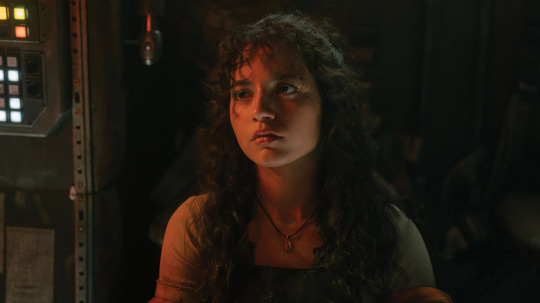
you can kinda see the necklace once you zoom in

This medal is easily identifiable even from the distance/lack of detail thanks to Catholic guilt! yay! This is a Miraculous Medal (pictured below)

This is a necklace that centers Mary with a whole bunch of lore attached that details how St. Catherine Labouré saw Mary in a vision (twice technically) and the second time was instructed to
“Have a medal struck upon this model. Those who wear it will receive great graces, especially if they wear it around the neck. Those who repeat this prayer with devotion will be, in a special manner, under the protection of the Mother of God. Graces will be abundantly bestowed upon those who have confidence.”
tldr: it's a very common and recognizable representation of Mary, they often have these medals at catholic churches as back when I worked at mine they were literally just sitting in the lobby.
What made me laugh so profusely in my car ride home is that Mary is considered literally THE mother in Christan lore and Kay does in fact give birth at the end of the movie... to what is essentially Weyland-Yutani Jesus.
Technically she took David's goo injection and produced the 'Offspring' (apparently what the horrifying human/xenomorph is called) (I prefer W-Y Jesus)
This is a wonderful bit of foreshadowing for the ending sequence, coupled with the engraving of Romulus and Remus and the Capitoline wolf, as well as the painting that was zoomed in on right before of a mother and child. And kinda as well to the whole thing about Weyland-Yutani trying to 'play God' with humanity's evolution.
But, on a larger more franchise-wide scale, this foreshadowing continues on with some of the themes from the previous two movies concerning origins and beginnings, as the whole Mary/Jesus thing is technically speaking, the 'origin/beginning' part of the New Testament. This is shown very plainly in the titles (Prometheus, Covenant, Romulus) which are all pulled from various origin stories - Greek, Abrahamic, and Roman. Prometheus stole fire, the covenants in the Torah/Pentateuch, and the founding of Rome. All different stories about the growth of humanity, ranging from how to live all the way up to founding empires. These ideas somewhat parallel the actual events of the movies.
B/c we watch David - and therefore Weyland-Yutani - discover the goo, experiment on it, learn how to interact with it, and then attempt to build a new empire with it.
It's a very messy analogy and kinda? does not fit with the Mary thing in Romulus, but in very broad strokes it ties in well enough, which for the whole confusing Prometheus/Covenant situation is par for the course.
Overall, Alien: Romulus is an amazing addition to the franchise and at the risk of sounding cheesy is literally a breath of fresh air. Right down to the pacing of the movie, it's classic Alien. I loved it, and even if you haven't seen any of the alien movies or even if you've only seen the first, and even if you have these spoilers, it's a fantastic experience!
(and for all the alien: isolation lovers there's such a cute nod to the game in the movie)
#alien romulus#alien#xenomorph#horror#space horror#Seriously thou I realized this in the passenger seat and the little religion major in me went crazy because that is such a detail#Also went even crazier as someone with a complicated relationship to Catholicism#And even crazier as someone who was literally wearing a miraculous medal the entire time#fuck!!!! I LOVE SPACE#also side note im not attempting to be sacrilegous or smthn just pointing out an interesting detail!#give me like three hours and I can explain in essay format how the last three alien movies could technically be religious horror#also all of the interaction with Andy was so interesting given what you think the movie is trying to say about AI#alien: romulus#alien: covenant#alien: isolation
97 notes
·
View notes
Photo

Zenobia's Rebellion in the Historia Augusta
The Historia Augusta (Great History) is a Latin work of the 4th century CE that chronicles the lives of Roman emperors from 117-285 CE. Among the many stories related is the history of Zenobia of Palmyra and her challenge to Roman authority which was crushed by the emperor Aurelian in 273 CE.
Zenobia (b. 240 CE, death date unknown) was the wife of the Syrian governor and founder of the Palmyrene Kingdom, Odaenathus (r. 263-267 CE) who was killed (or intentionally assassinated) on a hunting trip in 267 CE, leaving his young son Vaballathus (b. 259 CE, d. c. 273 CE) as successor. As Vaballathus was too young to reign at the time, Zenobia became regent for their son and expanded the kingdom of Palmyra into an empire.
Her rise to power took place during the chaotic period known as the Crisis of the Third Century (235- 284 CE, also known as the Imperial Crisis) when the central government was weak and various Barracks Emperors succeeded each other rapidly in rule. In this climate, no one noticed - or had the power to deal with - Zenobia's steady expansion of power until Aurelian (r. 270 - 275 CE) came to power and ended her ambitions, drawing the Palmyrene Empire back under the control of Rome. The story of Zenobia's rise and fall is given in a number of ancient works and, among them, is the Historia Augusta.
Historicity of Historia Augusta
While today the Historia Augusta is recognized as largely fictional (some scholars even giving it the label of "historical fiction"), it was considered reliable history in its time and for many centuries afterwards. The famous historian Edward Gibbon (l. 1737-1794 CE) accepted it as an authentic record of the ancient Roman history and relied on it extensively in his six-volume work The History of the Decline and Fall of the Roman Empire which, like the Historia Augusta, is largely viewed as inaccurate in the modern day. Both of these works, however, had significant impact on the audiences who read them or heard them read.
Rather than regard Historia Augusta as largely fictional, it would perhaps be better to consider it in the same light as one would the genre of ancient Mesopotamian naru literature. Naru literature began appearing around the second millennium BCE in Mesopotamia and is characterized by stories featuring a well-known figure from the past (usually a king) as the main character in a quasi-historical tale, which either extolled the king's military prowess, told the tale of his life and reign, or, more often, used the king to exemplify the proper relationship between human beings and the gods. The main character (king) was always an actual historical figure, but the story was either fictional or slanted in a particular way in order to achieve a desired impression.
While the Historia Augusta is not as concerned with the gods as it is with the Roman emperors, the same paradigm applies in that the tales of the Roman rulers are given as "teaching moments" through which one learns what it means to be a good monarch or a poor one, a great man or a failure. The work is certainly biased in its presentation but is understood to have drawn on reliable historical sources for its narratives. The focus of these narratives, however, is always on how effective - or paltry - a given emperor's reign was understood to have been. This model applies not only to the Roman emperors, however, but also to their adversaries and, most notably, to the Queen Zenobia of Palmyra.
Continue reading...
87 notes
·
View notes
Text
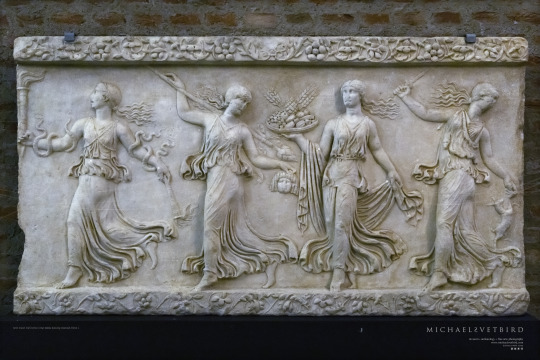
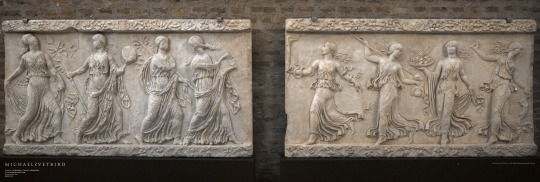
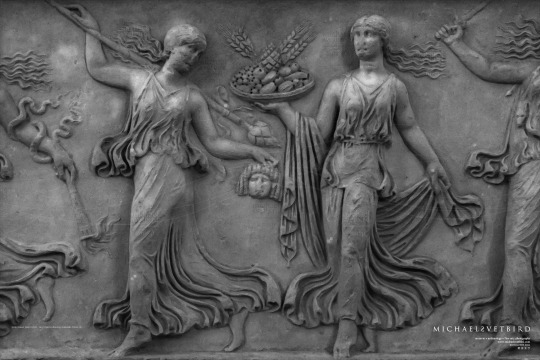
DANCING MAENADS: 2 Large Marble Frieze Reliefs H89 X W165 cm each, Roman "The female figures are faithful copies of the models created at the end of the 5th c. BC by the Greek sculptor Callimachus. Some, such as the maenad holding a basket full of fruit and the one screaming disheveledly brandishing two torches and with her arms wrapped in snakes, are however not typical of the Dionysian thiasos but refer to the iconography of an offering bearer or a Hora [season] and that of an Erinyes [personification of revenge especially towards those who attack one's family], themes that adapt to a funerary context." [txt ©MRT] White Marble Mid- 1st AD
LEFT [no faces preserved]
RIGHT [featured in this post].
Musei Reali Torino, Turin | MRT [Museum of Antiquities | Museo di Antichità, -1 Floor] • Web: https://museireali.beniculturali.it/en/archaeological-museum • FB: https://www.facebook.com/museirealitorino • IG: @ museirealitorino • X: @ MuseiRealiTo
MRT | Michael Svetbird phs©msp 18|02|24 6300X4200 600 [I.] The photographed objects are collection items of MRT, photos are copyrighted [non commercial use | sorry for the watermarks]
📸 Part of the "Reliefs-Friezes-Slabs-Sculpture" MSP Online Photo-gallery:
👉 D-ART: https://www.deviantart.com/svetbird1234/gallery/72510770/reliefs-friezes-slabs-sculpture
.
#turin#palazzo reale torino#musei reali torino#archaeological museum#museo archeologico#ancient sculpture#ancient art#roman#art history#antiquity#museology#archaeology#mythology#antiquities#heritage#ancient#sculpture#frieze#relief#maenads#maenad#dionysus#ancient greece#ancient rome#ancient world#sculpture photography#art photography#museum photography#archaeology photography#michaelsvetbird
118 notes
·
View notes
Note
Modern AU head-canons for these Dune characters:
Feyd Rautha
Glossu Rabban
Piter de Vries.
ohh okay this is interesting. I am not really that used to headcannons/ AUs, as I'm honestly new to engaging with fanfic in general so my apologies in advance if it doesn't totally fit, but here are my headcannons and ideas for how I'd do a modern AU with these characters.
Feyd Rautha:

Feyd Rautha is the heir apparent to a large spice mining company- in this case, you could substitute an oil or mining company for modern AU. The company culture is highly toxic, but Feyd likes that. He's known to churn through interns and keeps a non-existent sleep schedule.
His overall dynamic is finance bro meets basically any character from succession (think a slightly more financially literate Roman Roy). He buys luxury items just to fit in, however he has just enough taste so that it actually works. He considers most of these purchases a waste of money, but also his right and/or part of the job as heir.
As part of the Baron's inner circle, he has knowledge of most of the company's inner workings and takes great personal pride in digging up as much information as possible on the people he doesn't already control. He will often go to conferences and events just to get a read on competition. He secretly longs for someone to take that kind of an interest in him, but no one has just yet- many still think that he's too young and unpredictable to inherit.
After all- there is that rumor that he tried to kill the Baron.
Glossu Rabban
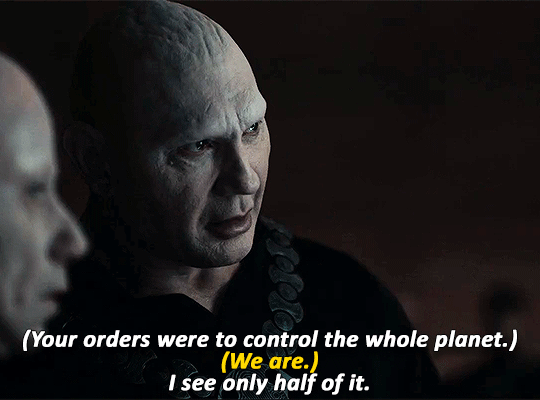
If Feyd is the more of a Roman Roy, Rabban is Conor. He had ambitions at the company which ended in failure, and has been reassigned to lobbying. Rabban is attempting to trade off of his industry connections to get into politics, if he can. He's aware his current position is tenuous at best and that he might need to make his own career. As the family industry is regulated, everyone basically hates this pipe dream of a career ambition. His moves are too obvious and clumsy, and he often tries to influence someone only to find that Feyd has already discussed the business with them. He's not a total failure, but his family just doesn't appreciate any success outside of financial success.
Piter de Vries
Piter is a math genius that works in data modeling and analytics. The Barron and Feyd love that he makes them money, however he's abrasive personality wise. He's known to use a myriad of drugs recreationally and at work, just because solving the same problems sober is too boring for him. The company has tried to hire assistants that can help him or at least explain his reports palatably, but he insists on doing the work himself and his own data models for fun in C. Not C++, C. The entire department rests on his shoulders and the Baron is weighing if Piter is worth putting up with. He gets the work of a department done on one salary, but also insists on making MILF jokes about lady Jessica basically any time she's within his zip code.
Would love to know your thoughts <3 Thanks for this ask!
55 notes
·
View notes
Note
What if the c in c. elegans stood for constantine?
I like the idea of turning a roman emperor into a ubiquitous model for genetic experimentation. there's a room under the NIH campus filled with Nero clones with messed-up Hox expression; the IRB mandates that each enclosure must have at least one lyre available at all times
10 notes
·
View notes
Text

Moses
Artist: Valentin de Boulogne (French, 1591–1632)
Date: c. 1625–1627
Medium: Oil on canvas
Collection: Metropolitan Museum of Art, New York City, NY, United States
Description
Moses holds a rod and the tablets with the Ten Commandments. (The Hebrew has been copied imperfectly: Was the text provided by Angelo Giori, a learned patron of Valentin whose portrait is in another gallery?) This is not the fierce, vigorous prophet sculpted by Michelangelo but an aged figure - we seem to recognize the model - absorbed in thought. The picture was meant to appeal to antiquarian interests, for Moses is classically garbed and over his blue toga he wears a Roman cloak, or paludamentum, decorated with a Greek meander pattern. In 1637, the picture was sold in Venice by the painter Nicolas Régnier - painters also acted as dealers - to James, third Marquis Hamilton; it then entered the Habsburg collections in Vienna.
#painting#moses#christianity#the ten commandments#biblical#old testament#valentin de boulogne#french painter#oil on canvas#fine art#french art#tablets#christian art
18 notes
·
View notes
Text
Orange Side's motives
Orange is on the war path against those who have wronged him. The song "Hell To Your Doorstep"-Thomas Borchert exemplifies what we have in store in the upcoming Sander Sides season finale. In the song, it describes the character Dante, overcome with rage, vows a terrible revenge on all his conspirators who wrongfully imprisoned him, including Mercédès, for she has betrayed him by stepping into a marriage with another man and having a child together. I believe Orange side will also take this route of revenge on those who are against him.
youtube
Who is Orange going to enact his vengeance on?
Janus
Nico
Patton
Roman/Remus
Janus
Let's start with Janus. Why would Orange want to enact revenge on him? Well who would want to be friends with their warden? You might be wondering, "You mean Janus is imprisoning Orange? Where are you getting this from?" Well PickYourPoison on their YouTube channel made a great theory video linking Janus's connection to the Orange side through his Christmas sweater.
Please go and give them a like and subscribe.
In summary, each side's Christmas sweater corresponds with a Christmas movie or Christmas theme. Patton's sweater is modeled after a gingerbread cookie, Logan's sweater is modeled after the movie "The Polar Express", Virgil's sweater is modeled after the story of "Rudolf the Red nosed Reindeer" and Roman and Remus's sweaters are modeled after the play "The Nutcracker". However, Janus's sweater is modeled after the 9 circles in Hell based on the book "Dante's Inferno". Where the sweater connects to both Janus and Orange is in the center of the sweater where a stripe contains a yellow eye. According to the video the stripe represents the 5th circle of Hell known as Wrath and Janus is keeping a watchful eye on it to make sure whatever is in there stays at bay. This is further supported by the frosted chains on the sweaters sleeves.
youtube
Janus's function is to not disclose things to c!Thomas that he doesn't want to know. However, since throughout the series c!Thomas made it his goal to learn more about himself. At first from Janus's perspective, he didn't take c! Thomas seriously about learning more about himself. Then Virgil got accepted by c!Thomas and light sides and that got Janus scrambling to get things in order so that he and the other sides will be prepared for Orange when he is eventually freed.
Nico
Now what could be the catalyst into freeing Orange side from their prison? Nico, more specifically how c!Thomas perceives his relationship with Nico. As, stated before the goal of the Sanders Sides series is for c!Thomas to learn more about himself. However, what sparks him towards this journey of introspection? His breakup with his previous boyfriend. We don't know much about what caused the breakup but from what we got from the episode "Moving On, Part 2/2 " that c! Thomas's boyfriend was not happy in their relationship and c! Thomas loved him so much that he wouldn't want to put his ex back into a situation like that again.
Sanders_Sides_Breakup_Scene
Before meeting Nico c!Thomas was getting over a breakup, trying to process whether or not he is a good person, questioning his sexuality(the Valerie thing during the Valentine's Day episode... that was an odd one ngl), navigating adulting,confronting the darker sides of himself, worrying whether or not he is on the right career path pursuing YouTube full-time, losing a callback that could have been his huge break just to go to a friend's wedding and is worrying about the prospect that he might be alone for the rest of his life. Now c!Thomas is rushing into another relationship without understanding why the previous relationship didn't work. And what's worse, I don't even think that c!Thomas even likes Nico as a person but as something to hold him over while he tries to gain some control over his own life.
Since the introduction of Nico we only know cursory things about him. Mainly what we have seen from his stickers and pins, that he is a music writer and that he likes art shows. Heck, what is the icon that c!Thomas associates Nico with in his contacts and wrapping for Nico's gift?A carrot.

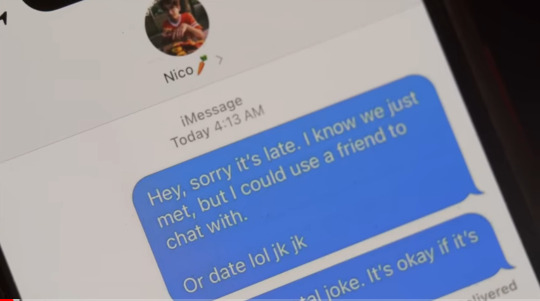
Yes, it is a cute nod to how they first met but also Thomas hates carrots. This isn't even speculation, we constantly get mixed signals from Patton about Nico on not knowing him and c!Thomas getting a trendy gift for Nico after not getting him anything for Christmas is suspicious. Whatever happened to break the relationship between c!Thomas and his ex may befall his relationship with Nico as well.
Patton's_mixed_feelings_on_Nico
Patton's_gift_to_Remus
Nico's_forgotten_Christmas_Gift
Patton
Speaking of Patton,why would Orange side want to enact revenge against him? Well I believe Patton maybe one of two sides responsible for Orange Sides imprisonment in the first place. Patton encompasses c!Thomas's morals that he was taught by his parents and encompasses most of c! Thomas feelings. Throughout the series Patton has been increasingly seen as being too controlling over c!Thomas's morality, leading to the reveal of Remus and making c!Thomas feel like he is a bad person for not sacrificing his free time to help others in need. This has caused a rift in Patton's relationship with Virgil. Patton tried to change by softening his approach on how he discusses moral issues but as we've seen in Putting Others First Redux that only disguised his intentions. After this episode's events where Janus gets accepted by c!Thomas and Patton, Roman who used to view Patton as a moral authority on issues no longer respects him. Now, Patton seems to afraid to voice his opinions anymore or else he'll be picked on by the other sides. He seems now to hangout more with Janus according to the music video episode "in Into The Unknown". However, Janus rarely tells him anything.
Patton_visits_Janus
Did Patton sentence Orange to be imprisoned or was his overbearing morals the reason why Orange had stayed imprisoned for so long? Either way, I would be enraged at a justice system that would lock me up and throw away the key.If Patton is the judge that sentenced Orange to prison, Janus is the warden keeping Orange prisoner, and Nico/c! Thomas's ex are the victims, then who was the cop that arrested him?
Roman and Remus
I suspect the culprit or should I say culprits are Roman and Remus. More specifically the being who was Creativity before Roman and Remus split. Why do I say this? Well let's look at the evidence.Roman is c!Thomas's creativity that revolves around his passions. Roman usually tries to portray himself as a hero guiding c!Thomas to achieve his hopes and dreams at the cost of c!Thomas's health.
Roman_wanting_Thomas_to_focus_on_desires
Roman's_dream_of_leaving_a_legacy
Roman is also the only side who is depicted fighting monsters. Such as the Dragon Witch and the manticore-chimera.

Roman's fear is being rejected and suffers from self-esteem issues.Virgil's Anxiety is the reason that gets c!Thomas out of bed in the morning and not seeking his hopes and dreams.
Anxiety_pressures_Thomas_to_get_out_of_bed
Roman fears his work being harshly criticized by Logan for not being good enough, professional enough, serious enough.
Roman_fear_being_criticized_by_Logan
Roman feels guilty that it's his fault that c!Thomas's desires are more important than doing good for others.
Roman's_guilt_that_his_desires_are_getting_in_the_way
c!Thomas assures Roman that he needs him but he doesn't know what feeling could motivate him into doing good.
If Roman is going through all of these existential issues, what issues did the Original Creativity have? Now for Remus, he is the side that represents Instrusive Thoughts. While he may provide random negative thoughts, it is up to c!Thomas on whether he will act on them or not.
Remus also seems to amplify c!Thomas's negative thoughts. For example, jumping to conclusions about being rejected by Nico.
Notice in this scene, that this is the only time Remus acted through fake Nico. Therefore, there is a high likelihood that Remus was told this before. I speculate that it was probably Roman who told him that after the feral cat incident.
So where am I going with this? Original Creativity carries both Roman's insecurities and Remus's amplification of negative thinking. There was a conflict between him and Orange side due to differing ideals. During the quarrel he thought of a terrible idea to win the fight and severely injured Orange side and caused Orange's imprisonment. Orange's views didn't sit well with Original Creativity. These conflicting viewpoints caused him to split into Roman and Remus.
Orange Side's Crime and What he Represents
We went through who wronged Orange side, now we need to know what crime did Orange commit and if he committed a crime at all? I suspect that Orange was trying to "unify" the sides under him instead c!Thomas. Orange represents hatred, more specifically retributive hatred which refers to hatred in response to wrongdoing, driven by a moral notion of desert. His reasoning is there is a principle of nature known as the Survival of the Fittest. The animal that wins has got to fight for it or else the animal will be taken advantage of by someone else. c!Thomas is that animal who is trying to survive, he is struggling and fighting to keep himself afloat. So Orange believes that he must become the side that c!Thomas must rely on the most for him to survive in this world. He values c!Thomas's self-worth but believes c!Thomas's indecisiveness makes him too weak too be behind the wheel of decision making. With Orange behind the wheel, he would ruthlessly crush anyone who gets in his way of achieving his goal of trying have c!Thomas achieve success in life. This idea is coming from the lyrics from the cut song "Biggering".
Orange Side's Influence on c!Thomas and his Personality
The influence of Orange has been prevalent throughout the series especially in the episode "Are There Healthy Distractions". In the episode c!Thomas is contemplating his friendship with Rico due to Rico informing him that he used to not support gay rights. That caused c!Thomas to angrily interrogate Rico and then returned to his apartment to roomenat on what happened.
Then Virgil brings up this:
"You only see things from your perspective and your perspective is your eyeballs looking out, away from you. And that makes it a lot harder to see your own flaws or where you went wrong."
Virgil later elaborates c!Thomas's behavior at the party:
"When Ricko brought up that he used to not support gay rights, maybe you shouldn’t have immediately started angrily interrogating him. Because he used the past-tense and he trusted you enough to share a history that he was not proud of with you.
And sure, he wouldn’t have gotten around to some of the stuff you wanted to know about on his own, but things might have gone smoother if you just calmly asked later. And, even though you had a right to feel angry, maybe you shouldn’t have taken your anger out on him because he’s right, he is a different person now.
And attacking a person for opinions that they don’t have doesn’t really do anybody any good. And even though he was kinda snobby when he told you that “your behavior is unacceptable”, you still shouldn’t have fired back, “oh yeah, like me kissing a man is unacceptable?” because again, he doesn’t feel that way anymore.
And he’s always been supportive and comfortable around you and your boyfriends and now maybe we ruined a good friendship ‘cuz we couldn’t see past his past and we put the final nail in the coffin by skipping out on the party!"
From this alone we have a good read on Orange side's personality. Orange can be vengeful. A vengeful personality is characterized by a desire to seek revenge or an unwillingness to forgive. He has an inability to manage negative emotions, especially anger. Orange seems to be unable to see his own wrongdoings even though his feelings of anger may be justified. Orange seems motivated by power, this is shown when c!Thomas started angrily interrogating Rico and attacking him for opinions that he doesn't have. Orange is willing to incur greater personal costs to get his revenge. This is shown with c!Thomas in a moment of anger was willing to risk losing his friendship with Rico just so that he could attack Rico for opinions he no longer holds. Even with Orange imprisoned, his presence is strong.
Orange Side and Logan
Finally, if Logan's logic is suppose to oppose Orange side's hatred, what relationship will Orange have with Logan? I suspect that Logan used to be apart of Orange. Not in an identical twin sense like Roman and Remus, but more like an Orange fruit missing a segment of itself. Logan used to be apart of Orange, his scene of reason, planning and foresight. To put in biological terms Logan was Orange's prefrontal cortex. When Orange was whole, he represented c!Thomas's sense of Truth about himself and the world and he worked along side Original Creativity who represented c!Thomas's Ideals for himself and the world. As c!Thomas grew Whole Orange noticed more and more that c!Thomas will need to acquire as much knowledge as possible so that c!Thomas can be successful and not be taken advantage of. However, his thirst for knowledge led him to be arrogant and controlling to a point where he tried to convince the other sides to work under him so that they can make c!Thomas a more productive and punctual version of himself.
However, it went poorly, much like how it went when Logan suggested that c!Thomas should get a real job and that he should be taken seriously. After Logan wanted to change c!Thomas's life around, Virgil says that "What you just suggested would be a massive change in Thomas's life. So, I kinda hate you right now and shut your dirty mouth."
So Whole Orange tried to take over control of c!Thomas by force.During the fight Whole Orange gets serverly injured to a point that a piece of him was severed from him. Then Orange was casted in c!Thomas's subconscious below. The piece that was severed from Orange was given new form and became the side we know today as Logan. Stricken with conflicting ideas Original Creativity soon split into two sides Roman and Remus. Roman upheld the morality that led to Orange's imprisonment while Remus abjectly rejects it to the point that he embodies an aspect of creativity that cannot be imprisoned or tamed. Intrusive Thoughts.
So, what will happen when Logan meets Orange side? I believe that Orange will try to convince Logan to become Whole with him again. Their combined power will allow Logan's wishes to be heeded and to be taken as a serious threat.
This has been foreshadowed in the episode "Working THROUGH Intrusive Thoughts" through the cover song "We Could Fly" - Sam Sparro, in the lyrics "Stop trying to rule the world" .
As for Orange, he will be able to grow in power, regain control over his negative emotions by using Logan's logic,work towards his goals of gaining control of c!Thomas and exacting revenge on those who have wronged him.
Logan, I am your Father
Yes, I know I pulled a "Luke, I am your Father" trope but the dialog just works so well here.
Orange- Logan, you have only begun to discover your power. Join me and I will complete your training. With our combined strength we can end this convoluted loop of self-destruction and bring order to c!Thomas.
Logan-In what scenario would I ever join you?
Orange-If you only know how powerful the motivation of vengence is. Nobody ever told you when your birthday was?
Logan- The closest approximation of my birthday is c!Thomas's birthday. It's impossible to determine when c!Thomas developed the qualities that came together to form me.
Orange-No Logan, your qualities originated from me. For you were once apart of me. I am your Father!
Logan-That's not true, that's impossible.
Orange-Search your feelings. The times you displayed your wrath towards others. You know it to be true!
Logan-No!
Orange- Logan, we can overthrow c!Thomas. I have foreseen this. It is your destiny. Join me Logan and together we can control c!Thomas's future as Father and Son!
youtube
I think I'm going to end it here. Sorry for the long essay. This has been on my mind for a while and I wanted to get this off my chest.
#Youtube#sanders sides#virgil sanders#remus sanders#logan sanders#thomas sanders#orange side#orange side theories#roman sanders#patton sanders
24 notes
·
View notes
Text
Episode 120: Spooky Lighthouse

Cody talks to his brother Gunner about his obsession with Lighthouses. Why are they so spooky? What are they for? Why is it a bad idea to have two men with the same name in the same one? Follow the flashing beacon to the answers as they try to solve a 124 year old mystery.
Episode art is by Gunner and you can see more of his art on his tumblr, @ohthatfranky.
Check out the images below discussed in this week's episode and please come join the episode discussion on the Least Haunted Discord!

The Lighthouse of Pharos (Alexandria) Constructed between 284 and 246 BCE.

The Tower of Hercules, A Coruña, Galicia, Spain. Built by the Romans ca. the 1st Century CE. It is the oldest lighthouse still in operation in the world.

A model of the Smalls Island Lighthouse as it appeared in 1801. This is where lighthouse keeper Thomas Howell spent several months alone with the corpse of his colleague, Thomas Griffith.

The lighthouse was replaced with a stone tower in 1861. This picture illustrates how wild the sea can get.

The Flannan Isles, aka, The Seven Hunters off the coast of The Isle of Lewis in the Outer Hebrides of Scotland.

The Flannan Isles Lighthouse.

From left to right: James Ducat, Thomas Marshall, Donald McArthur and Superintendent Robert Muirhead, c.1900. The first three men would vanish from The Flannan Isles Lighthouse on December 15th, 1900.
#leasthaunted#podcast#funny#paranormal#podcasts#skeptics#ghosts#cryptids#lighthouses#lighthouse#flannan isles#flannan isles lighthouse#haunted locations
8 notes
·
View notes
Text
was looking for some quotes from lewis to brat-ify and stumbled upon this article/interview with serena williams from 2017, which happened to have some interesting tidbits. so, here's my thoughts on me just talking about the whole thing! disclaimer: i am a relatively new f1 fan and also supposed to be asleep right now, so perhaps take some of the things i say with a grain of salt, and feel free to correct me!
website font is atrocious, at least for this kind of format. gdocs is claiming that it's courier new, which is usually okay when it's just by itself, but just urgh. bad
serena calls lewis things like "the very best" multiple times, which imo is a bit of a stretch, at least for the time being (article was published in july 2017, and he definitely wasn't viewed as such at the time); i figure she probably just doesn't know a super big amount about the sport outside of lewis
honestly really surprised that some of lewis's...less than favorable exploits were mentioned (e.g. crashing his car and partying with models) and were then followed immediately by "for someone who wants to be the best at everything, you just have to start somewhere".
lewis and serena's banter and the article are screaming 2017 and not necessarily in a good way 💀😭 getting many a painful flashback rn
talking about how a lot of the effort they (drivers) put into being fit for the car isn't seen at all by fans is pretty interesting
didn't realize he mentioned the whole locking himself in his hotel room thing before now?? damn :( he does seem to know that it was pretty unhealthy btp, which is good! in general rn he's sorta talking about how he's like, matured and calmed down and stuff.
inspiration section: his brother (perseverance) and serena (don't dim your light or smth)
apparently he used to be insecure about his catholicism, which i thought was a bit odd at first until i remembered that the us has only had two catholic presidents (jfk and biden) and that boris johnson "came out" as catholic a couple years ago. anyways he only rlly started embracing it AFTER getting to f1, which is sorta interesting. (how many people on the 2007 grid were catholic? lemme google) (post google search: i got lazy, but the answer is that there weren't many. massa seeeems to be roman catholic, but idk how similar that is to catholic catholicism)
serena compliments lewis on his singing and asks when he's gonna release his album (real). his response is that a) he's a hyperperfectionist who takes forever to finish songs and b) he's worried that if he thinks too much about releasing it it'll take the fun out of it (fair).
[lewis] doesn't really wanna do his own clothing or vehicle lines or whatever b/c he likes collabing w/ people a lot
he was designing a motorcycle at the time apparently??? and he's done it before???? WHERE'RE THE MOTORCYCLES LEWIS???? WHERE ARE THEYYYYYYYYYY
rapid-fire question time!
HE HASN'T EATEN MEAT IN TWO YEARS ATP??? oh my god guys new lewis lore just dropped!!! (the question was chicken or fish and he said fish, so i'm guessing he doesn't count fish as meat, soooo i'm taking this to mean that he was pescatarian (diet where you eat no meat other than fish) for two years)
overall, the lewis in this interview feels like he's in a bit of a transition phase atm in terms of character development and stuff, which makes sense considering, well. *gestures*
quotes i liked/found interesting:
"And more than anything, I fear not being as great as I know I can be."
"My dad wanted me to have a better life than he had ever had. He wanted us to succeed so badly. And I never wanted to let him down."
"I manage myself. I chose this team myself. So there’s a huge satisfaction for me."
"I feel like people are expecting me to fail, therefore, I expect myself to win. Just like you—everyone knows how good you are, and they’re just waiting for you to fall."
"I’ve realized that winning isn’t everything. It’s very much about the journey ... So while winning is definitely the ultimate goal, the lessons learned when I don’t win only strengthen me."
"I hate losing. It doesn’t matter if it’s racing or playing Ping-Pong, I hate it. 'You’re either first or you’re last.'"
8 notes
·
View notes
Text



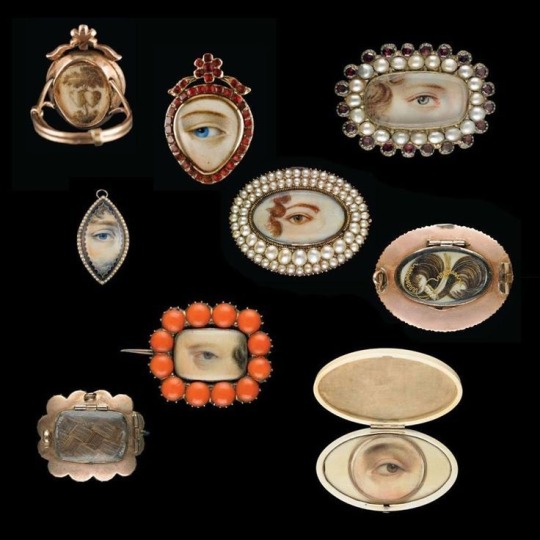




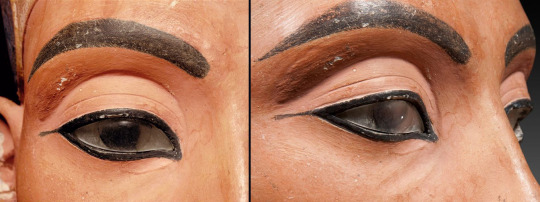


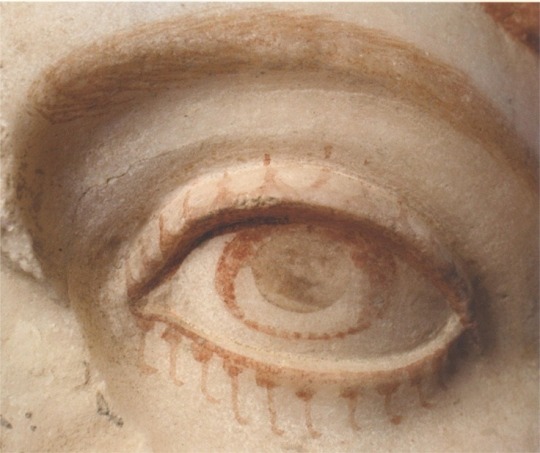
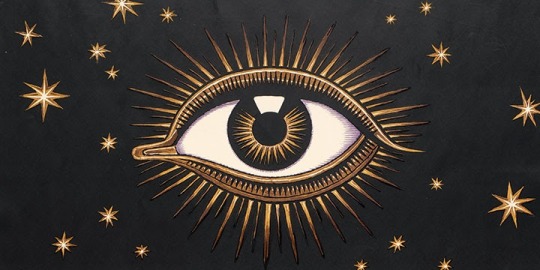
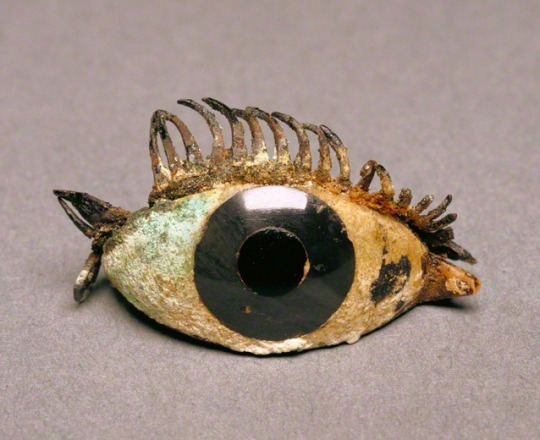
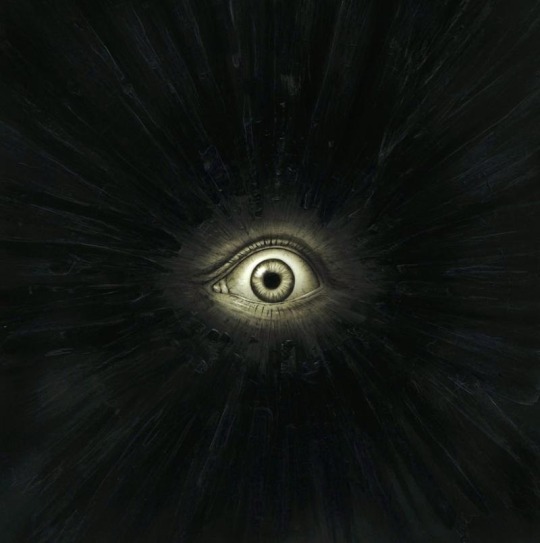

sand dunes - aerial view
Filthy Luker - aka Luke Egan (British) - Art Attack - street art
Elodie Antoine (Belgian, working in Brussels) - Chemisier aux yeux boutonnés (Blouse with Eye-buttons) - cotton blouse, print on textile - 2014
'Lovers Eyes' jewelry - originated in the 18th century - collection of David and Nan Skier
Damien Cadio (French, b.1975) - Cyclone eye - oil on canvas - 25x31 cm - 2017
glass eye from coffin - Egypt, Late Period (724-333 BCE)
Emilio Villalba (American, b.1984) - Red Eye
Gérard DuBois (French, b.1968) - Moby Dick
Nefertiti right eye (two views) - sculptor's portrait model - limestone, painted stucco, quartz, wax - the iris and pupil of the right eye made of beeswax dyed black, covered with a thin piece of polished rock crystal as a cornea - Egypt, Tell el-Amarna, New Kingdom, 18th Dynasty, c.1351–1334 BCE
Louise Bourgeois (French/American, 1911-2010) - Nature Study (Velvet Eyes) - 1984
Michael Hussar (American, b.1964) - Lovers Eyes
painted eye an Amazon - marble - Herculaneum - Roman, before 79 CF
cosmic eye (all-seeing eye, mystic eye) - poster
right eye from a Greek statue - marble, obsidian, glass, copper - 500–100 BCE
Rainer Kalwitz (German, working in Recklinghausen) - The Eye in the Abyss
Bro. William Preston (Scottish,1742–1818) - The Eye Of Providence
23 notes
·
View notes